My Jeep recovery gear
1 Offroad vehicle recovery is a very important and very broad topic, that every offroading junkie should be familiar with. Every responsible person should be prepared for situations when their offroading adventure is interrupted by a situation where recovery is necessary. The list of recovery gear is long and includes everything from a shovel to a winch. There are many opinions on what are best brands of recovery gear of course. People also have different opinions when it comes to best recovery techniques and minimum requirements for your recovery gear.
Offroad vehicle recovery is a very important and very broad topic, that every offroading junkie should be familiar with. Every responsible person should be prepared for situations when their offroading adventure is interrupted by a situation where recovery is necessary. The list of recovery gear is long and includes everything from a shovel to a winch. There are many opinions on what are best brands of recovery gear of course. People also have different opinions when it comes to best recovery techniques and minimum requirements for your recovery gear.
One thing is sure, high quality gear is going to be expensive. You have to remember that you’re going to be trusting your safety and sometimes your life to your gear, so do not try to buy and use equipment that is untested and cheap knockoff just to save money. Make smart decisions.
I’m not an expert in this topic and I’ll never claim to be one. I’m just learning by listening to others and slowly gaining more experience. The equipment I’m acquiring for myself might not be what you prefer. I’m only sharing what I believe will work for my vehicle and the type of offroading I do. I own a Jeep JK with some modifications, and wheel in Arizona, so it’s mostly desert. Terrain includes sand, mud and rocks.
I believe the first thing you need to consider when deciding on recovery gear is the type and weight of your vehicle. Your gear is going to differ depending on whether you drive an ATV, side-by-side, Jeep, or a large pickup truck. You have to know how heavy your rig is. Based on some research, I gathered that an average ATV weighs somewhere between 400-800 lbs. An average side-by-side weighs between 1,200-1,600 lbs. A Jeep JK 2DR comes in at about 4,500 lbs stock, but after few mods it’s closer to 5,000 lbs. Jeep JKU 4DR is closer to 5,700 lbs after few mods. An average pickup truck like a Dodge Ram 1500 or Ford F150 weighs somewhere around 5,200 lbs, but the 2500’s or 250’s can weigh more than 7,500 lbs. You have to build you recovery kit based on your needs. Always remember to buy gear with WLL (Working Load Limit) that meets or exceeds your vehicle’s weight!
Like I said, I drive a 2-door JK so my Jeep recovery gear is going to match that 5,000-lb weight (2.5 tons). Some of that gear will be identical no matter what vehicle you drive, but that’ll be just a few items.
Here is a list of gear I am going to gather (some of it I already own, some is still on my wishlist):
1. shovel and gloves
2. recovery points (bow shackles for the front, receiver hitch shackle for the rear)
3. recovery/snatch strap
4. tow strap
5. winch
6. winch rope dampener
7. tree saver strap
8. snatch block
9. hi-lift jack
10. traction mats
11. tire repair kit
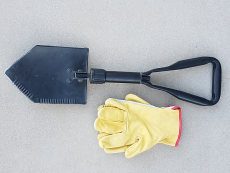 1. The easiest way to start building your recovery gear kit is by purchasing such basic items as a pair of comfortable leather gloves and a shovel. Sometimes all you need to do to get unstuck and moving again is to dig your tires out. I decided not to buy a full size shovel but instead bought myself a folding shovel. You can find this awesome military-issue Ames e-tool shovel online or in a surplus store. It is way more than just a shovel, as shown in this video. It can be very useful not only on the trail and in a recovery situation, but also when you’re camping or hunting. Harbor Freight has a great selection of work gloves at good prices. You can read about where I store these simple tools in my jeep in this article.
1. The easiest way to start building your recovery gear kit is by purchasing such basic items as a pair of comfortable leather gloves and a shovel. Sometimes all you need to do to get unstuck and moving again is to dig your tires out. I decided not to buy a full size shovel but instead bought myself a folding shovel. You can find this awesome military-issue Ames e-tool shovel online or in a surplus store. It is way more than just a shovel, as shown in this video. It can be very useful not only on the trail and in a recovery situation, but also when you’re camping or hunting. Harbor Freight has a great selection of work gloves at good prices. You can read about where I store these simple tools in my jeep in this article.
 2. Most vehicles come with recovery/tow points, both front and rear. Some cars might require you to assemble the recovery point (always consult your vehicle’s manual for exact location). Before you go out on a trail, make sure you have front and rear recovery points correctly installed, and they should be frame mounted or part of a properly attached bumper.
2. Most vehicles come with recovery/tow points, both front and rear. Some cars might require you to assemble the recovery point (always consult your vehicle’s manual for exact location). Before you go out on a trail, make sure you have front and rear recovery points correctly installed, and they should be frame mounted or part of a properly attached bumper.
My jeep comes with two hooks in the front stock bumper and one hook loop under the rear bumper on driver side. I still have stock bumpers (modified to a stubby version) so I am also considering getting a receiver hitch with a bow shackle, so my rear recovery point is located in the center. I will eventually buy steel aftermarket bumpers with two integrated recovery points both in the front and rear.
I already own four bow shackles that I selected based on my jeep’s weight. By the way bow/anchor shackles are commonly mistakenly called d-ring shackles, even though they are not technically the same and for offroad recovery only bow shackles are appropriate.
They are 3/4″ body & 7/8″ pin shackles with 4.75 ton WLL (always remember to check that the shackle has the info listed right on it, do not buy ones with no info on it).
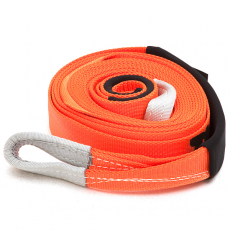 3. Recovery or snatch strap is a piece of equipment used to help in the recovery of vehicles bogged or stuck in sand or mud. Snatch straps are manufactured from webbing that is capable of approximately 20% stretch under load. This stretching property allows the strap to store kinetic energy, which is used to pull vehicles from a bog. Snatch straps are typically between 20 ft and 50 ft in length, with 30 ft being a common size.
3. Recovery or snatch strap is a piece of equipment used to help in the recovery of vehicles bogged or stuck in sand or mud. Snatch straps are manufactured from webbing that is capable of approximately 20% stretch under load. This stretching property allows the strap to store kinetic energy, which is used to pull vehicles from a bog. Snatch straps are typically between 20 ft and 50 ft in length, with 30 ft being a common size.
Strap rating should be about 3 times the weight of your vehicle. Too much strength is not a plus. It would cause the strap not to stretch and instead would yank, more like a chain. For my jeep I selected a recovery strap rated at 17500 lbs capacity.
There are also great quality recovery ropes with much higher breaking strength of 28,600 lbs.
Remember that a recovery strap is not the same as a tow strap! A snatch strap should never be used for towing, since it might turn into a giant slingshot and cause an accident.
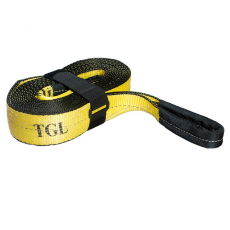 4. A tow strap is used to tow a disabled vehicle off the trail to a safe location where it can be fixed or placed on a tow truck. It is not used to pull a vehicle that is stuck or bogged in sand or mud. It is made of strong nylon or polyester and has no stretch to it. Try to avoid tow straps with hooks, as these seem to be the weakest point and might break under stress. Instead use tow straps with reinforced loop ends, and attach them to recovery points with bow shackles. Find a tow strap that is rated at about 3 times the weight of your vehicle and 20′ long. For myself I decided to go with this tow strap rated at 30,000 lbs capacity, which gives me about 10,000 lb WLL. It is a total overkill, since my little 2-door JK has a towing capacity of 2,000 lbs! A 4-door JKU has a towing capacity of 3,500 lbs though.
4. A tow strap is used to tow a disabled vehicle off the trail to a safe location where it can be fixed or placed on a tow truck. It is not used to pull a vehicle that is stuck or bogged in sand or mud. It is made of strong nylon or polyester and has no stretch to it. Try to avoid tow straps with hooks, as these seem to be the weakest point and might break under stress. Instead use tow straps with reinforced loop ends, and attach them to recovery points with bow shackles. Find a tow strap that is rated at about 3 times the weight of your vehicle and 20′ long. For myself I decided to go with this tow strap rated at 30,000 lbs capacity, which gives me about 10,000 lb WLL. It is a total overkill, since my little 2-door JK has a towing capacity of 2,000 lbs! A 4-door JKU has a towing capacity of 3,500 lbs though.
Remember that a tow strap is not the same as a recovery strap!
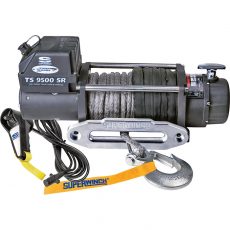 5. Selecting a winch is more of a personal preference, since there are several manufacturers and they all make great quality winches (Warn, Superwinch, Milemarker, Ramsey, Smittybilt, Rugged Ridge, BullDog, and others). You just have to remember to select one that is rated at about 2 times your vehicle weight. For my 2-door JK I decided to go with a Superwinch Tiger Shark 9500 SR (just my personal choice based on friends’ experience), but for a 4-door you might want to look for something closer to a 12,000 lb rating.
5. Selecting a winch is more of a personal preference, since there are several manufacturers and they all make great quality winches (Warn, Superwinch, Milemarker, Ramsey, Smittybilt, Rugged Ridge, BullDog, and others). You just have to remember to select one that is rated at about 2 times your vehicle weight. For my 2-door JK I decided to go with a Superwinch Tiger Shark 9500 SR (just my personal choice based on friends’ experience), but for a 4-door you might want to look for something closer to a 12,000 lb rating.
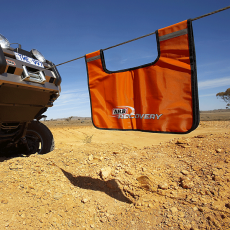 6. The purpose of a winch rope dampener is to help reduce the risk of injury due to recoil in the event of a winch line or recovery strap failure. If your winch line snaps it can seriously injure or even kill a person standing in it’s path. To avoid that, you want to place a proper rope dampener blanket (it’s basically a vinyl jacket with pockets on both sides to put weights in) at the mid point of the line. It’s designed to absorb the energy from the cable if it were to snap, thus reducing recoil and preventing the likelihood of harm to persons standing by.
6. The purpose of a winch rope dampener is to help reduce the risk of injury due to recoil in the event of a winch line or recovery strap failure. If your winch line snaps it can seriously injure or even kill a person standing in it’s path. To avoid that, you want to place a proper rope dampener blanket (it’s basically a vinyl jacket with pockets on both sides to put weights in) at the mid point of the line. It’s designed to absorb the energy from the cable if it were to snap, thus reducing recoil and preventing the likelihood of harm to persons standing by.
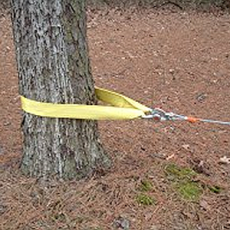 7. A tree saver strap is a short, wide strap made to go around a tree to prevent cable from digging into the bark and killing the tree, when you use the tree as your anchor point for winch recovery. They have little to no stretch to them. You should be OK with getting a 3″ wide and 8′ long tree saver strap, as long as it is rated at about 3 times the weight of your vehicle.
7. A tree saver strap is a short, wide strap made to go around a tree to prevent cable from digging into the bark and killing the tree, when you use the tree as your anchor point for winch recovery. They have little to no stretch to them. You should be OK with getting a 3″ wide and 8′ long tree saver strap, as long as it is rated at about 3 times the weight of your vehicle.
If you wheel in places like the rocky desert in Arizona, you know there are not too many strong trees out on the trails. We do have plenty of huge boulders though, that could be used as anchor points. For that reason I decided to go with a longer tree saver strap and got a 3″ wide and 16′ long one. The fact that it’s 16′ long also means that in a pinch I can use it as a tow strap (you should not do that with the 8′ long strap because that would not provide a safe distance between your vehicle and the disabled one behind you).
 8. A snatch block is a pulley block with one side plate that un-clips and swivels open. This allows the user to place the winch cable directly on to the pulley wheel without having to unhitch the load or thread a large distance of cable through the block. Simply open the side and fit the cable, close and secure. The two primary functions of a snatch block in recovery winching is to change the direction of your winch cable when the anchor point is offset, and to increase the pulling power of your winch. You can learn about winching techniques from this video.
8. A snatch block is a pulley block with one side plate that un-clips and swivels open. This allows the user to place the winch cable directly on to the pulley wheel without having to unhitch the load or thread a large distance of cable through the block. Simply open the side and fit the cable, close and secure. The two primary functions of a snatch block in recovery winching is to change the direction of your winch cable when the anchor point is offset, and to increase the pulling power of your winch. You can learn about winching techniques from this video.
When selecting a snatch block make sure it is rated at minimum 2 times your vehicle’s weight.
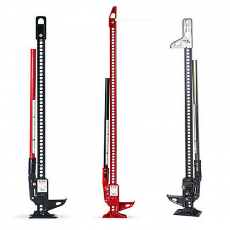 9. A high lift jack is a very useful and valuable piece of recovery equipment. Useful, but dangerous if operated incorrectly! It can be used for many tasks that involve lifting, pushing, pulling, winching and clamping when you’re on the trail. It comes in two sizes: 48″ and 60″. Pick the size that works for your vehicle height. High lift jack can be used for lifting a vehicle off a rock or when it’s stuck in sand or mud. You can use it as a manual winch. It can be used to break the tire bead if necessary. It can also be used as a giant clamp or spreader. These jacks have a capacity of up to 3.5 tons, they weigh about 30 lbs.
9. A high lift jack is a very useful and valuable piece of recovery equipment. Useful, but dangerous if operated incorrectly! It can be used for many tasks that involve lifting, pushing, pulling, winching and clamping when you’re on the trail. It comes in two sizes: 48″ and 60″. Pick the size that works for your vehicle height. High lift jack can be used for lifting a vehicle off a rock or when it’s stuck in sand or mud. You can use it as a manual winch. It can be used to break the tire bead if necessary. It can also be used as a giant clamp or spreader. These jacks have a capacity of up to 3.5 tons, they weigh about 30 lbs.
High lift jack should not be used for changing a flat tire! It is very unstable due to its small base and it requires appropriate jacking points that can accept the jack safely, and most vehicles do not have them.
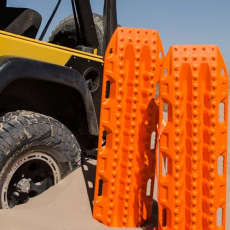 10. A traction mat is a very simple yet effective recovery tool. If you are axle-deep in sand, snow, gravel, or mud, a traction mat, after a little shovel work, can be placed in front or behind the bogged tires and it creates a ramp to drive out on. They are great in situations when you get yourself stuck at a location with no anchor points like trees or boulders anywhere near your vehicle. Based on great reviews from others who use them, I decided that I will eventually get me a pair of Maxtrax mats, because they are light, stackable and easy to carry with hand grips on each side. When you flip them upside down, they can be even used as a shovel. Their tapered ends fit easily under a tire with minimal digging. While their top surface is full of tire-biting traction cleats, the bottom has cups that greatly increase their ground traction, preventing them from slipping backward. Made from reinforced nylon, they are quite tough, but under heavy use some of the top cleats might start to wear off or bend.
10. A traction mat is a very simple yet effective recovery tool. If you are axle-deep in sand, snow, gravel, or mud, a traction mat, after a little shovel work, can be placed in front or behind the bogged tires and it creates a ramp to drive out on. They are great in situations when you get yourself stuck at a location with no anchor points like trees or boulders anywhere near your vehicle. Based on great reviews from others who use them, I decided that I will eventually get me a pair of Maxtrax mats, because they are light, stackable and easy to carry with hand grips on each side. When you flip them upside down, they can be even used as a shovel. Their tapered ends fit easily under a tire with minimal digging. While their top surface is full of tire-biting traction cleats, the bottom has cups that greatly increase their ground traction, preventing them from slipping backward. Made from reinforced nylon, they are quite tough, but under heavy use some of the top cleats might start to wear off or bend.
I admit they are not cheap, but there are other brands available.
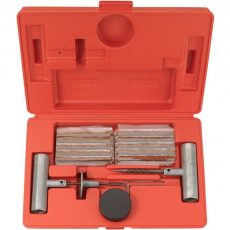 11. A tire repair kit is essential to carry on all offroading trips. Sometimes you’ll find yourself in a situation where changing a tire is not possible. These plug kits will allow you to repair punctures by removing the foreign object, reaming the puncture hole to make room for a plug, and inserting a sticky self vulcanizing tire plug to seal the hole. These plugs work on the tread area of a tire, they are not meant to be used on the sidewall. You will be repairing the tire form the outside only, so it’s not advisable to keep this as a permanent fix. For a permanent fix, the tire should be dismounted and the inside of the plugged hole should be treated with a bonding agent. The plugs included with this kit and similar products will get you back home or to a tire shop where you can get a permanent fix.
11. A tire repair kit is essential to carry on all offroading trips. Sometimes you’ll find yourself in a situation where changing a tire is not possible. These plug kits will allow you to repair punctures by removing the foreign object, reaming the puncture hole to make room for a plug, and inserting a sticky self vulcanizing tire plug to seal the hole. These plugs work on the tread area of a tire, they are not meant to be used on the sidewall. You will be repairing the tire form the outside only, so it’s not advisable to keep this as a permanent fix. For a permanent fix, the tire should be dismounted and the inside of the plugged hole should be treated with a bonding agent. The plugs included with this kit and similar products will get you back home or to a tire shop where you can get a permanent fix.
Like I mentioned in the introduction to this post, I do not claim to be any kind of expert in this topic, but I’m slowly learning, since I find recovery gear to be absolutely essential for all offroading trips. To have fun out there you need to be prepared for the worst, both in terms of equipment and knowledge.
I realize that some might not agree with my opinions or choices in gear. I will add to this list or update it when I find new useful items I can include in my recovery gear kit. I am open to feedback and advise. You can comment below this article if you wish to share your thoughts with me or other visitors.
One thought on “My Jeep recovery gear”
Leave a Reply
You must be logged in to post a comment.


Exactly what I was looking for to help find the basics needed. And also live in AZ.